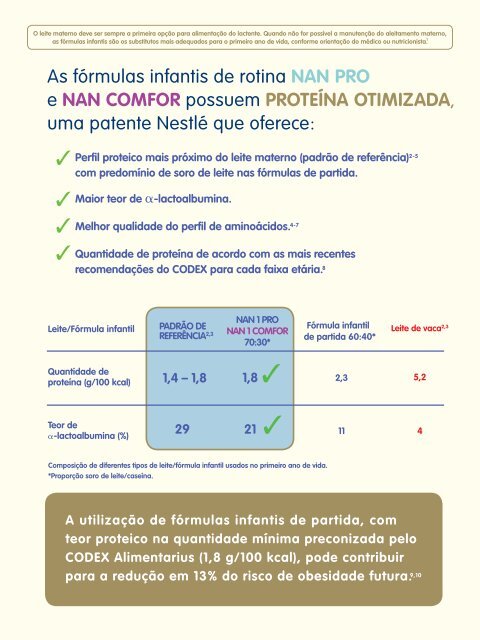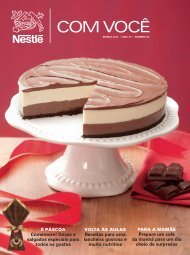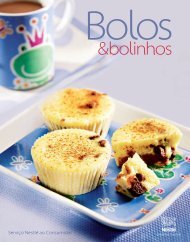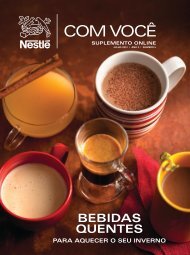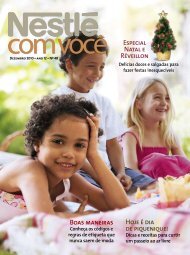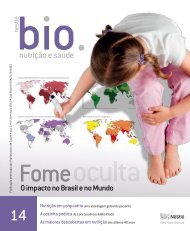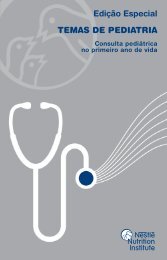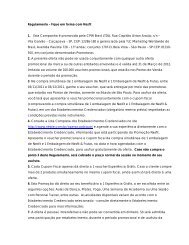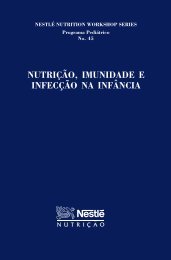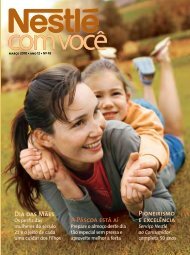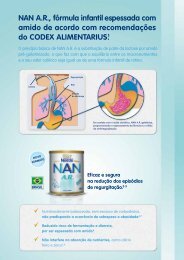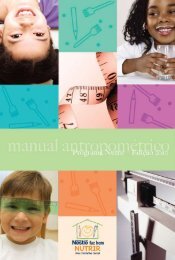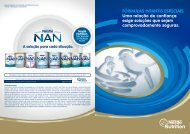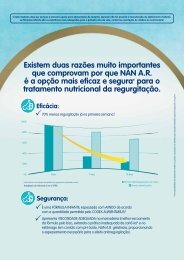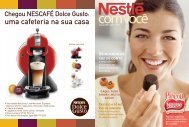As fórmulas infantis de rotina NAN PRO e NAN COMFOR ... - Nestlé
As fórmulas infantis de rotina NAN PRO e NAN COMFOR ... - Nestlé
As fórmulas infantis de rotina NAN PRO e NAN COMFOR ... - Nestlé
- No tags were found...
Create successful ePaper yourself
Turn your PDF publications into a flip-book with our unique Google optimized e-Paper software.
Fórmulas <strong>infantis</strong> <strong>de</strong> <strong>rotina</strong> <strong>NAN</strong>:as únicas com o menor teor proteicoe a melhor qualida<strong>de</strong> <strong>de</strong> aminoácidos. 4-8NI021111A fórmula infantil mais completae com perfil nutricional maispróximo do leite materno(padrão <strong>de</strong> referência). 4,5,11-14A melhor opção <strong>de</strong> fórmula infantilcom prebióticos. 15-20*Em relação às <strong>de</strong>mais <strong>fórmulas</strong> <strong>infantis</strong> disponíveis no mercado.<strong>NAN</strong> <strong>PRO</strong> e <strong>NAN</strong> <strong>COMFOR</strong> não contêm glúten.NW006A-1, LEB015-1, NW045-1, LEO52NOTA IMPORTANTE:AS GESTANTES E NUTRIZES PRECISAM SER INFORMADAS QUE O LEITE MATERNO É O IDEAL PARA O LACTENTE, CONSTITUINDO-SE A MELHOR NUTRIÇÃO E <strong>PRO</strong>TEÇÃO PARA ESTAS CRIANÇAS. A MÃEDEVE SER ORIENTADA QUANTO À IMPORTÂNCIA DE UMA DIETA EQUILIBRADA NESTE PERÍODO E QUANTO À MANEIRA DE SE PREPARAR PARA O ALEITAMENTO AO SEIO ATÉ OS DOIS ANOS DE IDADE DA CRIANÇA OUMAIS. O USO DE MAMADEIRAS, BICOS E CHUPETAS DEVE SER DESENCORAJADO, POIS PODE TRAZER EFEITOS NEGATIVOS SOBRE O ALEITAMENTO NATURAL. A MÃE DEVE SER PREVENIDA QUANTO À DIFICULDADE DEVOLTAR A AMAMENTAR SEU FILHO UMA VEZ ABANDONADO O ALEITAMENTO AO SEIO. ANTES DE SER RECOMENDADO O USO DE UM SUBSTITUTO DO LEITE MATERNO, DEVEM SER CONSIDERADAS AS CIRCUNSTÂNCIASFAMILIARES E O CUSTO ENVOLVIDO. A MÃE DEVE ESTAR CIENTE DAS IMPLICAÇÕES ECONÔMICAS E SOCIAIS DO NÃO ALEITAMENTO AO SEIO – PARA UM RECÉM-NASCIDO ALIMENTADO EXCLUSIVAMENTE COMMAMADEIRA SERÁ NECESSÁRIA MAIS DE UMA LATA POR SEMANA. DEVE-SE LEMBRAR À MÃE QUE O LEITE MATERNO NÃO É SOMENTE O MELHOR, MAS TAMBÉM O MAIS ECONÔMICO ALIMENTO PARA O LACTENTE.CASO VENHA A SER TOMADA A DECISÃO DE INTRODUZIR A ALIMENTAÇÃO POR MAMADEIRA É IMPORTANTE QUE SEJAM FORNECIDAS INSTRUÇÕES SOBRE OS MÉTODOS CORRETOS DE PREPARO COM HIGIENERESSALTANDO-SE QUE O USO DE MAMADEIRA E ÁGUA NÃO FERVIDAS E DILUIÇÃO INCORRETA PODEM CAUSAR DOENÇAS. OMS – CÓDIGO INTERNACIONAL DE COMERCIALIZAÇÃO DE SUBSTITUTOS DO LEITEMATERNO. WHA 34:22, MAIO DE 1981. PORTARIA Nº 2.051 – MS DE 08 DE NOVEMBRO DE 2001, RESOLUÇÃO Nº 222 – ANVISA – MS DE 05 DE AGOSTO DE 2002 E LEI 11.265/06 DE 04.01.2006 – PRESIDÊNCIA DA REPÚBLICA– REGULAMENTAM A COMERCIALIZAÇÃO DE ALIMENTOS PARA LACTENTES E CRIANÇAS DE PRIMEIRA INFÂNCIA E TAMBÉM A DE <strong>PRO</strong>DUTOS DE PUERICULTURA CORRELATOS.Referências bibliográficas: 1. Socieda<strong>de</strong> Brasileira <strong>de</strong> Pediatria. Departamento <strong>de</strong> Nutrologia. Manual <strong>de</strong> orientação para alimentação do lactente, do pré-escolar, do escolar, do adolescente e na escola. Socieda<strong>de</strong> Brasileira <strong>de</strong> Pediatria. Departamento <strong>de</strong>Nutrologia – 2ª ed. - São Paulo: SBP, 2008. 120p. 2. American Aca<strong>de</strong>my of Pediatrics, Committee on Nutrition. Formula Feeding of Term Infants. In: Pediatric Nutrition Handbook. 5th ed, 2004; 1178p. 3. Blanc B. Biochemicah aspects of human milk. Comparisonwith bovine milk. Wld Rev Nutr Diet 1981;36:1-89. 4. Raiha NCR, et al. Whey Predominant, Whey Modified Infant Formula with Protein/Energy Ratio of 1.8g/100kcal: A<strong>de</strong>quate and safe for term Infants From Birth to Four Months. J Pediatr Gastroenterol Nutr.2002;35:275-281. 5. Bachmann C and Haschke-Becker E. Plasma amino acid concentrations in breast-fed and formula-fed Infants and reference intervals. Infant Formula: Closer to the Reference. <strong>Nestlé</strong> Nutrition Workshop Series Pediatric Program vol 47Supplement. Nestec Ltd/Lippincott Willians & Wilkins.2002;121-137. 6. Heine WE, Klein PD, Reeds PJ. The importance of alpha-lactoalbumin in infant nutrition. J Nutr 1991 Mar;121(3):277-83. 7. Heine W, Radke M, Wutzke KD et al. Alpha-lactoalbumin enrichedlow protein infant formulas: a comparison to breast milk feeding. Acta Paediatr 1996 sep;85(9):1024-8. 8. Penchartz P, Elango R. Protein. In: Pediatric Nutrition in Practice. Koletzko B. Basel: Karger, 2008. Switzerland. p. 37-42. 9. Koletzko B, von Kries R, Closa R,Escribano J, Scaglioni S, Giovannini M, Beyer J, Demmelmair H, Gruszfeld D, Dobrzanska A, Sengier A, Langhendries JP, Rolland Cachera MF, Grote V; European Childhood Obesity Trial Study Group. Lower protein in infant formula is associated with lowerweight up to age 2 y: a randomized clinical trial. Am J Clin Nutr. 2009 Jun;89(6):1836-45. 10. Grote V, von Kries R, Closa-Monasterolo R et al. Protein intake and Growth in the first 24 months of life. JPGN 2010;51(3):S117-S118. 11. Brenna JT, Varamini B,Jensen RG et al. Docosahexaenoic and arachidonic acid concentrations in human breast milk worldwi<strong>de</strong>. Am J Clin Nutr 2007;85:1457– 64. 12. Gueimon<strong>de</strong> M, Laitinem K, Salminen S, Isolauri E. Breast milk: a source of bifidobacteria for infant gut <strong>de</strong>velopmentand maturation. Neonatology 2007;92:64-66. 13. Singhal A, Macfarlane G, Macfarlane S, Lanigan J, Kennedy K, Elias-Jones A, Stephenson T, Du<strong>de</strong>k P, Lucas A. Dietary nucleoti<strong>de</strong>s and fecal microbiota in formula-fed infants: a randomized controlled trial.14. Rochat F, Cherbut C, Carclay D, Puccio G, Fazzaroli-Nesci A, Grathwohl D, Haschke F. A whey-predominant formula induces fecal microbiota similar to that found in breast-fed infants. Nutrition Research 2007;27:735-740. 15. Vivatvakin B, MahayosnondA,Theamboonlert A, Steenhout P, Conus N. Effects of a Whey predominant starter formula containing LcPufas (DHA/ARA) and Oligosacchari<strong>de</strong>s (GOS/FOS) on gastrointestinal comfort in infants. Abstract accept to apresentation in <strong>As</strong>ia Pacific Congress ofPediatrics, Shanghai, October 14-18, 2009. 16. Costalos C, Kapiki A, Apostolou M, Papathoma E. The effect of a prebiotic supplemented formula on growth and stool microbiology of term infants Early Hum Dev. 2008 Jan;84(1):45-9. 17. Faust K, Litov R, ZieglerE. Publication 5820.4. Effects of Prebiotic-Containing Infant Formula on Commensal Microbiota. Annals of 2008 Pediatric Aca<strong>de</strong>mic Societies’ Annual Meeting. Hawaii, Honolulu. May 3-6; 2008. 18. Scientific Committee on Food (2001). Statement on the use ofresistant short chain carbohydrates (oligofructose and oligogalactose) in infant formulae and in follow-on formulae, expressed on 26 September 2001. 19. Scientific Committee on Food (2001). Additional statement on the use of resistant short chain carbohydrates(oligofructosyl-saccharose and oligogalactosyl-lactose) in infant formulae and in follow-on formulae, expressed on 13 December 2001. 20. Veitl V, et al. Akzeptanz, toleranz und wirksamkeit von milupa comformil bei säuglingen mit kleineren ernährungs – undverdauungsproblemen. J Ernährungsmed. 2000;2:14-20.<strong>As</strong> <strong>fórmulas</strong> <strong>infantis</strong> <strong>Nestlé</strong> são fabricadas <strong>de</strong> acordo com os mais altos padrões <strong>de</strong> higiene.Como as <strong>fórmulas</strong> <strong>infantis</strong> não são produtos estéreis, as instruções <strong>de</strong> preparo <strong>de</strong>vem ser rigorosamente seguidas.Acesse o nosso site e obtenha mais informações: www.nestle.com.br/nutricaoinfantilServiço <strong>de</strong> Atendimento Nutrição Infantil ao Profissional <strong>de</strong> Saú<strong>de</strong>:0800-7701599Material <strong>de</strong>stinado exclusivamente aos Profissionais <strong>de</strong> Saú<strong>de</strong>. Proibida a distribuição a consumidores.


